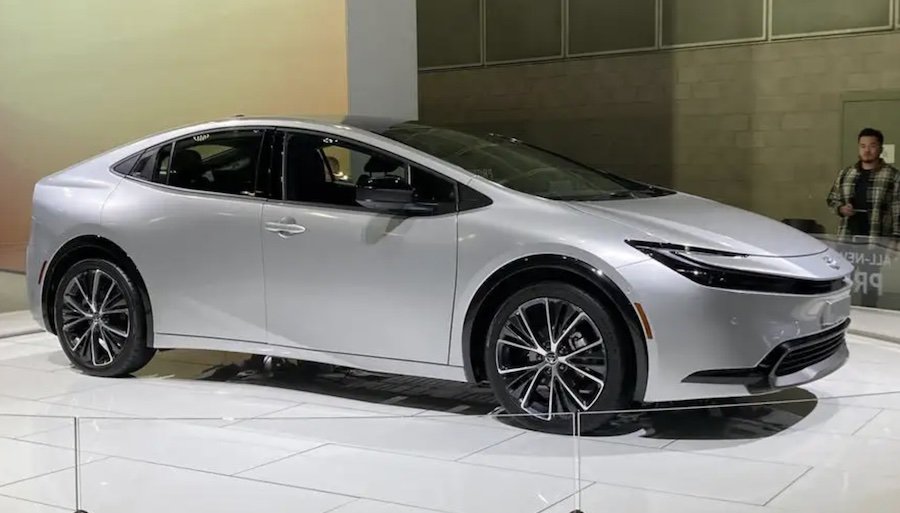New 2023 Toyota Prius PHEV makes show debut in Los Angeles

The radically reinvented, fifth-generation Toyota Prius is official, bringing a dramatic design and technology evolution while switching exclusively to plug-in hybrid power.
Revealed overnight in Japan, the new Toyota Prius represents an obvious departure from the outgoing car, and will be the first generation to not be sold in the UK, with Toyota citing a change in buyer habits - reflected in a shift to other models.
In a statement sent to Autocar, Toyota said: "With our evolving UK product strategy and changing market conditions, we have taken the decision not to introduce the new generation Prius in the UK as the new model represents a very different proposition to its predecessor, alongside a clear shift in UK consumer demand towards more SUV style vehicles.
"Since its introduction as our first hybrid model back in 2000, over the years we have launched a much greater selection of self-charging hybrids, covering all the main segments of the market meeting a much wider customer base.
"Acknowledging its popularity in the private hire market, we are still able to cater for operators who continue to require our reliable hybrid technology, with the UK built Corolla Touring Sports estate.
"This shift in UK market conditions has been reflected in Prius sales figures – there were 563 sales in 2021, in comparison to just under 18,000 hybrid Toyota C-HRs. Prius will continue to be sold in other European markets and will only be available as a plug-in version."
In other European markets, the Prius will no longer be sold with Toyota's long-running full-hybrid drivetrain, which made its debut in the original Prius and helped establish the brand as a front-runner of the initial wave of electrification.
The new drivetrain – an upgraded version of that used by the previous Toyota Prius Plug-in – pairs a 147bhp 2.0-litre four-cylinder petrol engine with a 158bhp EV motor on the front axle for a combined 221bhp, 100bhp up on its predecessor.
Official figures put the 0-62mph time at 6.7sec, making this the quickest Prius yet, and Toyota says the larger engine matches the fuel efficiency of the previous 1.8-litre unit, which in Autocar's testing returned an MPG figure in the high 60s.
Toyota highlights that the battery's improved energy density allowed for a tangible EV performance boost without a compromise to interior space. The battery is located entirely under the rear seat, which means the floor did not have to be raised and keeps the centre of gravity low.
EV power, meanwhile, is supplied by a 13.6kWh battery said to boost EV range by 50%. This would suggest the new Prius can travel around 58 miles with the engine off, which would be one of the longest EV ranges of any PHEV on sale.
Full charging specs will be revealed at the Prius's European debut on 5 December, but Toyota has confirmed that the standard-fit solar roof panel can generate enough energy for 777 miles of EV driving per year. As well as charging the battery when the car is parked, solar energy is also used to power the air conditioning and other internal systems.
A more familiar version of the full-hybrid system will be offered with the Prius in other markets, with the more powerful 2.0-litre version boosting performance to 191bhp compared with 136bhp in the old 1.8-litre car.
The new Prius is built around the latest version of Toyota's TNGA architecture, said to be stiffer, quieter and more stable than the previous structure. The company says that the various structural improvements and the revised powertrains, together, mean the new Prius "delivers a captivating driver performance".
The technical reinvention is accompanied by a wide-reaching design overhaul aimed at making the Prius a much more visually striking proposition than its predecessors. The basic wedge shape, a feature of all previous Prius generations, is retained, but the new car sits 50mm lower than before, the roof's peak sits further back and the wheels are now 19in as standard - for a more purposeful, coupé-inspired stance.
With an eye on aero-efficiency, Toyota's designers have also kept creases and flourishes to a minimum (a key differentiator over the previous car), and changes to the structure mean the car is now 46mm shorter overall but has a 50mm longer wheelbase. It is also 22mm wider than its predecessor – an increase accentuated by the new 'hammerhead' front light bar.
It's a similar story inside, where the interior has been revamped with a focus on material quality and driver comfort. A 7.0in digital driver display is standard fitment, positioned to minimise distraction while on the move, and is paired with a new-generation central infotainment screen based on that from the latest Toyota Corolla and Toyota RAV4.
On the decision to dramatically reinvent its hybrid flagship, Toyota said: "While the Prius has played a leading role in driving hybrid use, the current spread of HEVs through a wide range of models means it has reached a turning point.
"The development team decided to start from scratch and look at what the Prius needs to remain popular for the next 25 years. Based on a desire to renew the Prius itself and communicate the appeal of hybrid cars to an even wider audience, the Hybrid Reborn concept was created."
Since launch in 1997, Toyota has sold around 5.05 million examples of the Prius worldwide, which it says equates to a CO2 saving of more than 82 million tonnes. A variation of the hybrid system it pioneered is now available in all core Toyota models on sale in the UK.
More details on specification and pricing for European Prius models will be given in the coming months.
